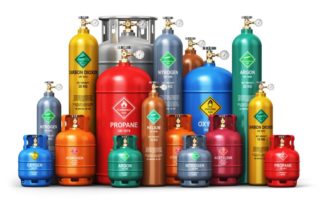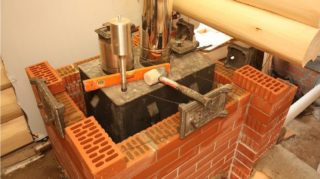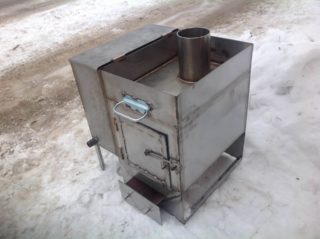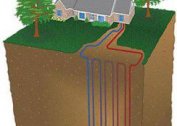The bath helps to cope with pathogenic bacteria and germs, relax and gain strength. Therefore, the owners of country houses are thinking about her project on their own site. If there is no desire to look for builders, the owners can cook the stove in the bathhouse on their own.
Description of the furnace for a bath

The sauna stove works to heat the premises of the bathhouse, wash water and stones to form fumes. Thanks to her, there is steam and constant heat in the steam room.
Any heating bath device consists of the necessary parts:
- Firebox. Here, the burning of fossil fuels takes place, at the exit highly heated flue gases are obtained.
- Ashpit. Located under the firebox.
- Blew. A door through which air flows into the firebox.
- Chimney valve. Designed for traction. The wider the damper opens, the faster and more intensively the raw materials burn out and the room heats up. In order not to lose heat, the valve closes after complete combustion and cooling of the coals.
- Coil (boiler). The main function is water heating.
- Kamenka is a steam generator.
The most common option for a steam room is a wood-burning stove. It consists of a furnace, grate, an ash pan and a chimney. It is made of brick or metal. Despite the relatively small dimensions, it is able to heat a spacious room.
It is recommended to build a wood-burning stove in buildings without a centralized gas supply.
Cast iron stoves are:
- temporary burning - heated by firewood;
- continuous burning - gas or liquid fuel is used.
In the first case, the steam room can only be located after complete combustion of the raw materials. In the second - all the time.
Electric stoves are available in different sizes, different capacities and efficiencies. Electric power devices quickly raise the temperature to set points and last a long time. But there is one minus - such a stove for a bath cannot be welded with your own hands.
Advantages of heating structures
Homemade metal structures have undeniable advantages:
- minimum cost;
- accessibility of materials for construction;
- simple installation mechanism;
- high fire safety;
- compact sizes;
- fast heating;
- long operational period;
- simple after-sales service.
For welding and installation of a metal furnace does not need a package of permits.
It is worth to familiarize yourself with minor flaws and take them into account in future use:
- continuous monitoring of the working stove is required;
- possible burns after accidental contact.
A brick stove holds much more heat than a metal stove. However, regular maintenance of temperature in this case eliminates this drawback.
Heating options
Stoves differ in the type of fuel used. The most affordable raw materials are solid fuels, in particular wood. Burning logs heat up the whole area and saturate the room with pleasant aromas. No wiring or gas communications needed. This is a salvation for a site where electricity and gas supplies often fail.
Minuses:
- systematic chimney cleaning;
- continuous close monitoring of compliance with fire safety standards;
- the need for pre-harvesting firewood;
- continuous tossing into the furnace of resources.
An alternative to wood is gas. For gas-fired bath stoves, it is imperative that a gas thermostat and fuse be installed to avoid leakage. Blue fuel is characterized by efficiency: the room is heated in a matter of minutes. However, a connection to a common line or a constant supply of liquefied liquid fuel in cylinders is required.
Combined stoves run on natural gas, kerosene, diesel fuel and logs. The variety of working materials is explained by additional elements in the equipment: gas burner parts (burners, filters, valves) and mechanisms for laying logs.
There is a negative effect of kerosene and diesel fuel on the atmosphere inside the bath: bad smells and reduced fire safety.
Electrical units are famous for a number of advantages:
- compactness;
- thermal conductivity;
- durability;
- uniform heating of the entire area;
- support for optimal temperature conditions.
A significant drawback: the inability to work without a stable power supply and the high cost of the device. Therefore, the owners of country cottages or houses give preference to metal stoves that work on solid materials.
Preparatory work
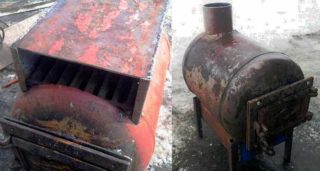
To properly weld the stove in the bathhouse, you need to prepare: design a drawing of the future unit, coordinate the position of the stove in the room and the features of bringing the required communications to the device.
It is important to prepare tools and building materials:
- sheet metal with a thickness of more than 8 mm;
- thick-walled pipe in diameter not less than 50 mm;
- rebar 10 mm;
- cast iron grate;
- doors for a stove, a furnace and a blower;
- chimney pipe;
- grinder for cutting iron;
- tank for water;
- welding machine.
We must not forget about personal safety during installation. Must have a special suit with mittens and a protective mask.
It should be stocked with tape measure, level, plumb, grinding wheels, a technical knife, rags and a set of spatulas. Only after full readiness can you start to cook the sauna stove.
DIY stove making
The simplest stove is created in the following steps:
- A meter pipe is used to create a heater, 0.7 m of pipe is used to make a tank under water.
- At the bottom of the future steam generator, a cutout will be made for the blower with a width of 20-25 cm and a height of 6-10 cm. A thick metal plate must be welded to the upper edge. In the glued element, holes are cut for the location of the grate.
- In the same pipe, holes for the furnace 25-30 cm are made. The pipe itself is installed in a horizontal position. Fasteners are carried out using hooks.
- At the top of the furnace section is a piece of pipe under the heater (depth * length = 12 * 30). The pipe must be welded for a solid fit. The stage ends with mounting the door of the appropriate size.
- The steam generator is filled with stones. For improved durability, a bar of steel reinforcement is welded along the top of the heater.
- On top of the furnace, a coupling is mounted made of a steel tire 50 mm wide. A water vessel will attach to the protruding end.
- A circle is cut out in a steel sheet. In the resulting figure, a hole is made for installing a chimney communication with a diameter of 100 mm or more. The cut circle is tightly welded to the pipe. It is important that this seam is extremely strong: water should not penetrate the firebox.
- A hole for the chimney is made of steel in a semicircle using a grinder. A pipe is welded to the hole. The top of the tank closes. An adjustment cover with a handle is mounted on the remaining segment.
Finishing touches: weld and metal streaks are removed using a grinder and a stripping mechanism.
Increased room heating rate
To avoid heat loss, you can turn to brickwork. It is performed on clay mortar with fireclay chips or powder. Used brick 65 mm.
To increase productivity, it is recommended to adhere to several conditions:
- between the metal structure and the masonry to maintain a distance of 10-15 cm;
- between the bricks, an upper and lower hole is formed, which will ensure uninterrupted air circulation.
The minimum masonry height is three rows of bricks. If desired, full cladding of the unit is allowed.
Safety regulations
You can not install a finished stove immediately in the room. Before installation, the unit should work idle in the fresh air 3-5 times. They position the oven so that the firebox and the front door are on the same line and “look at each other”. Around the apparatus, the wall and floor surfaces are covered with steel, an additional heat-insulating layer.
It is also important to observe other points:
- seams are welded tight;
- no wooden materials or flammable objects near the stove;
- chimneys need to be cleaned regularly so that accumulated soot does not catch fire.
A stove in a bathhouse is a fundamental element. Instead of buying an expensive device, you can purchase materials and make a stove with your own hands. The installation process is not the most difficult, but it requires compliance with all standards, rules and permits.

